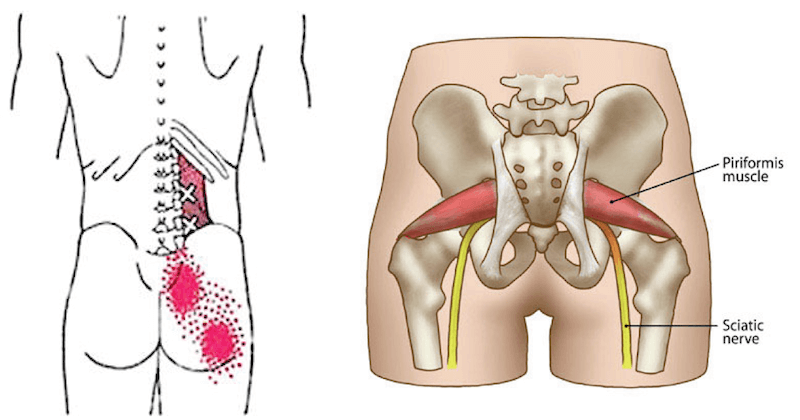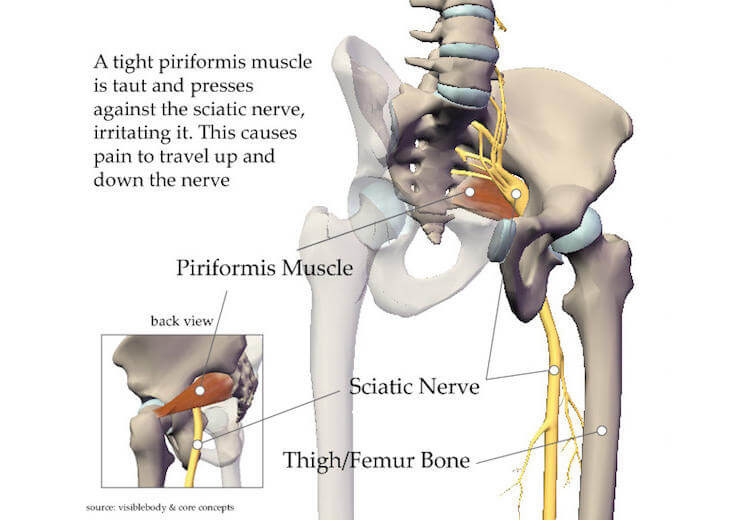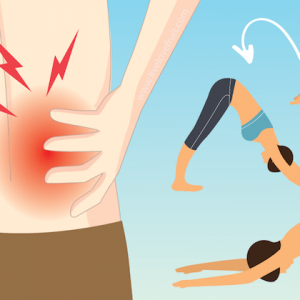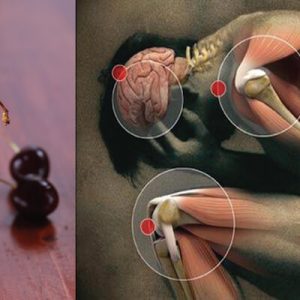Sciatica is a condition that many people suffer from. It is characterized by low back pain caused by a pinched nerve. It can also make it quite uncomfortable to sit down on one side of the body and can lead to progressive lower extremity weakness and numbness in the upper thighs.
The sciatic nerve is the longest nerve in the body, and it starts in your lower back, later splitting to run through the hips, buttocks, legs and feet on both sides (1). When problems start, pain is usually only felt on one side of the body, and some people will experience fewer symptoms than others.
In some people, sciatica can persist for a long time, and this is where the different causes of sciatica pain come into play.
The most common diagnosed cause of sciatica is a herniated disc that presses on the sciatic nerve. When the disc herniates, it can put pressure on the nerves around it, and when the sciatic nerve is irritated, it can create lots of pain. Bone spurs and spinal stenosis can also put pressure on the sciatic nerve in the lower back (2). These issues are usually what cause more chronic cases of sciatica.
However, what most doctors don’t consider is the role that muscles play in irritating the sciatic nerve. If they have ruled out everything else, but still can’t determine the root cause, keep reading.
Root Cause of Sciatica
In many cases, the cause of sciatica pain is actually a tight or misaligned muscle.
The piriformis muscle is a small muscle located deep in the buttock (behind the gluteus maximus). It starts at the lower spine and connects to the upper surface of each femur (thighbone), and functions by helping rotate the hip and turning the leg and foot outward.
On its way to attach to the hip joint, the piriformis muscle passes through a tunnel of bone and ligaments called the greater sciatic foramen. Many different nerves and blood vessels also pass through this tunnel, the largest of them being the sciatic nerve (3).
A tight piriformis muscle, when tight and inflamed, can press against the sciatic nerve and cause irritation. This will result in pain that travels up and down the sciatic nerve (aka. lower back pain, hip pain, buttock pain, and even numbness and tingling along the back of the leg and into the foot).
If the cause of your back pain is actually a tight piriformis muscle rather than a herniated disc, then your road to recovery will be must faster, and more easily treated.
Stretching For Relief
Stretching does wonders for releasing a tight and constricted piriformis muscle. It can help put into place any misalignments in the body, and it can also reduce inflamed muscles by allowing blood to flow to those areas again.
As with all stretching, go slow, and ease into stretches. Breathe deeply, and if you feel any sharp pain, back off from the intensity of the stretch and get into a position that is maybe a little less deep. Most importantly, be patient with your body!
1. Figure Four Stretch
1. Lie on the floor with the affected leg crossed over the other leg at the knees, both legs bent.
2. Gently pull the lower knee up toward the shoulder on the same side of the body until you feel a stretch in the affected leg.
3. Hold for 30 seconds, and then slowly return to starting position.
2. Supine Piriformis Stretch
1. Lie on your back with your legs flat.
2. Pull the affected leg toward the chest, holding the knee with the hand on the same side of the body and grabbing the ankle with the other hand.
3. Pull the knee towards the opposite shoulder until stretch is felt.
4. Hold for 30 seconds, then slowly return to starting position.
3. Standing Piriformis Stretch
1. If you have trouble balancing, stand with your back against a wall, and walk your feet forward 24 inches. Position your knees over your ankles, then lower your hips 45 degrees toward the floor.
2. Lift your right foot off the ground and place the outside of your right ankle on your left knee.
3. Lean forward and lower your chest toward your knees while keeping your back straight.
4. Stop when you feel the glute stretch.
5. Hold for 30-60 seconds, then switch legs and do the same.
4. Seated Stretch
1. In seated position, cross your right leg over your left knee.
2. Bend slightly forward, making sure to keep your back straight.
3. Hold for 3-60 seconds and repeat on the other side.
5. Pigeon Pose
1. Come into a kneeling position, and rest your weight into the affected hip. Bring the opposite knee back to about 90 degrees, and the affected foot forward, as far as it feels comfortable so there is no pulling.
2. Place your hands on either side of the affected knee, and lift out of the hips to hinge forward, giving a nice stretch into the affected hip.
3. Breathe deeply for 30 seconds, and maintain a nice length in the spine. Do not round the spine, keep it long and tall, and keep yourself propped up with your hands. Eventually, you may be able to come down to your forearms.
Other Alternative Methods
There are many effective, non-invasive treatments for sciatic nerve pain that don’t involve digging into the body. Below are just some of the few. For a more comprehensive list, check out the article I wrote here.
• Hot and Cold Compress: alternating between hot and cold can help reduce inflammation and relieve pain. An ice pack held to the affected area, followed by a heating pad, and then replaced with an ice pack will encourage blood to flow to the area to loosen tight muscles.
• Trigger Point Therapy: a modality employed by professional massage therapists for the release of points in the body that trigger referred pain elsewhere. Combining this with stretching, yoga and even chiropractic can greatly help alleviate pain.
• Devil’s Claw: this herb has been found to be just as powerful and useful as ibuprofen (4). People with sciatica should aim for 1,500 to 2,000 mg twice a day. Look for brands that contain around 50 mg of harpagoside, the active compound in Devil’s claw. Avoid if you are on blood-thinning medications or have peptic ulcers.
• Turmeric: a major anti-inflammatory herb that can help reduce inflammation in and around the sciatic nerve (plus the health benefits of turmeric extend beyond just reducing inflammation in the body). You can mix 1 teaspoon of turmeric powder in 1 cup of warmed coconut milk with a pinch of black pepper to create a delicious golden milk.










MY DAUGHTER HAS A MUSCULAR/NERVE PAIN WHICH IS UNBEARABLE. SHE IS UNABLE TO FIND ANY RELIEF
FOR IT. SHE CAN NOT SEEM TO FIND ANY CAUSE OR RELIEF FROM THESE PAINS. SHE ALSO HAS A PAIN IN HER NECK AREA THAT IS UNCONTROLLABLE. Why? Hours after hour of internet searching has left her unable
to find any explainable relief r comfort. Can you understand her frustration and the need from pain day in and day out? Can you help or offer to her where she can find relief?
Has she tried doing yoga, consistently, for at least a month? Sometimes things take time to fall back into place where they belong (like muscles and nerves that are out of alignment). I would suggest reducing the consumption of inflammation-causing foods (see the link below), as this will make the pain feel worse. Maybe go seek out a good chiropractor – for me, yoga has worked better than any chiropractor (I practice the 26 asana's, known as "Bikram" yoga, but I do them at home, and don't associate Bikram with them – they're just an intelligent set of poses that help the body tremendously).
Oops – here is the link: https://livelovefruit.com/foods-that-cause-inflammation-weight-gain-10-ways-to-fight-it/
SHE IS IN A TERRIBLE NEED TO FIND RELIEF FROM HER PAINS. SHE SAID YESTERDAY THAT IF SHE DID NOT GET SOME RELIEF SOON THAT SHE HAS NO DESIRE TO GO ON LIVING. THIS IS A LOUSY WAY TO LIVE AND A HORRIBLE ALTERNATIVE TO LIFE. IT IS HARD TO SAY, BUT IF THE MEDICAL PROFESSION CAN ONLY SEE
DOLLAR SIGNS IN THE WAY OF PRESCRIPTIVE DRUGS, THEN WE ARE IN A SAD STATE OF AFFAIRS. WE NEED
HELP, NOT DRUGS.
If you have more questions, please contact me at [email protected] – I'm here to help.